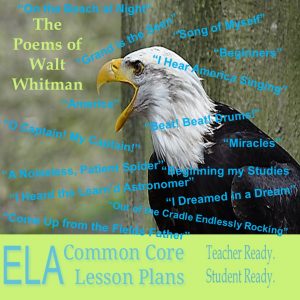Before we start talking about poems with assonance and consonance, feel free to download this Sound Devices in Poetry lesson plan.
Understanding Assonance and Consonance

Imagine having 11 complete poetry units with handouts and lesson plans completed. You don’t need to imagine. These units are teacher ready and student ready. Just print, make copies, and accept accolades from colleagues and students.
How much do you know about poetry? Make it your goal to get to Master Level:
- Monkey Level – Level 1 involves memorizing definitions. Even a monkey can do this if it really wants to. Without progression, however, this knowledge is wasted.
- Post-primate Level – Level 2 involves being able to identify consonance, assonance, and other sound devices in poetry.It requires more than simple memorization, yet has very little relevance outside of a classroom.
- Scholar Level – Level 3 requires scholarly aptitude. It requires you to interpret the use of sound devices and explain the author’s purpose in using them.
- Master Level – Level 4 requires using assonance and consonance in your own writing to create a specific effect. The writing can be poetry, but a true master can use it in other settings–essays, letters, speeches.
Examples of Assonance in Poetry
Assonance is the repetition of vowel sounds in nearby words. Examine the following examples of assonance in poetry to gain a better understanding.
Poem: “Eldorado” by Edgar Allan Poe
Example of Assonance: Eldorado, shadow, old, over, boldly, no
Analysis: The quick rhythm of the poem is slowed by the use of the long o sound, thereby drawing the reader’s attention to the oft repeated words Eldorado and shadow. These two words emphasize the meaning of the poem, the knight’s quest. Eldorado is a legendary place of great wealth and opportunity which overshadows everything the knight does.
Poem: “Anabel Lee” by Edgar Allan Poe
Examples of Assonance: (1) maiden, may, there, name, away, angels; (2) year, see, Anabel Lee, winged, reason; (3) many, maiden; (4) out, cloud, our
Analysis: The frequent use of assonance and other sound devices contributes to the poem’s haunting mood.
These two examples of assonance in poetry should give you a good start. Now let’s turn our attention to examples of consonance in poetry.
Examples of Consonance in Poetry

It’s time to go home and you aren’t finished with your poetry unit. No problem. This Walt Whitman poetry unit is teacher ready and student ready. Download. Print. Copy. Teach.
Consonance is the repetition of consonant sounds at the end or in the middle of words. Examine the following examples of consonance in poetry to gain a better understanding.
Poem: Beat! Beat! Drums! by Walt Whitman
Examples of Consonance: (1) Blow! Bugles! Blow! (line 1); (2) windows, doors (line 2); (3) through, ruthless; (4) scatter, congregation (line 3); there’s an example in every line.
Analysis: Whitman’s poem is an excellent example of stylistic devices matching content. The constant consonance mimics the constant beating of the drum. A few lines from the first stanza stand out: the repetition of the l sound imitates the blowing of a bugle, yet manages to capture the intensity of a bugle blow war call; Line five begins “Leave not the bridegroom quiet” pairing the two words not and quiet, a battle reality.
Poem: “The Eagle” by Lord Alfred Tennyson
Examples of Consonance: (1) He clasps the crag with crooked hands; (2) Close to the sun in lonely lands; (3) Ringed with the azure world he stands.
Analysis: Line one begins with the repetition of the hard c or k sound–another example of poetic devices emphasiziing content–as the reader is immediately placed into the harsh desert environment of the eagle. Line two contains two examples of consonance: close and sun are linked; lonely has the double l sound, making it stand out in a line full of l sounds. The consonance in line three involves a much softer r sound, emphasizing ringed, think crowned, azure, think limitless sky, and world, think…world. Line three captures the majesticness of the eagle, setting the reader up for its heroic descent in the second stanza.
